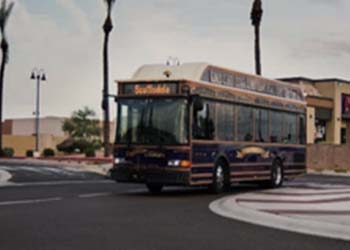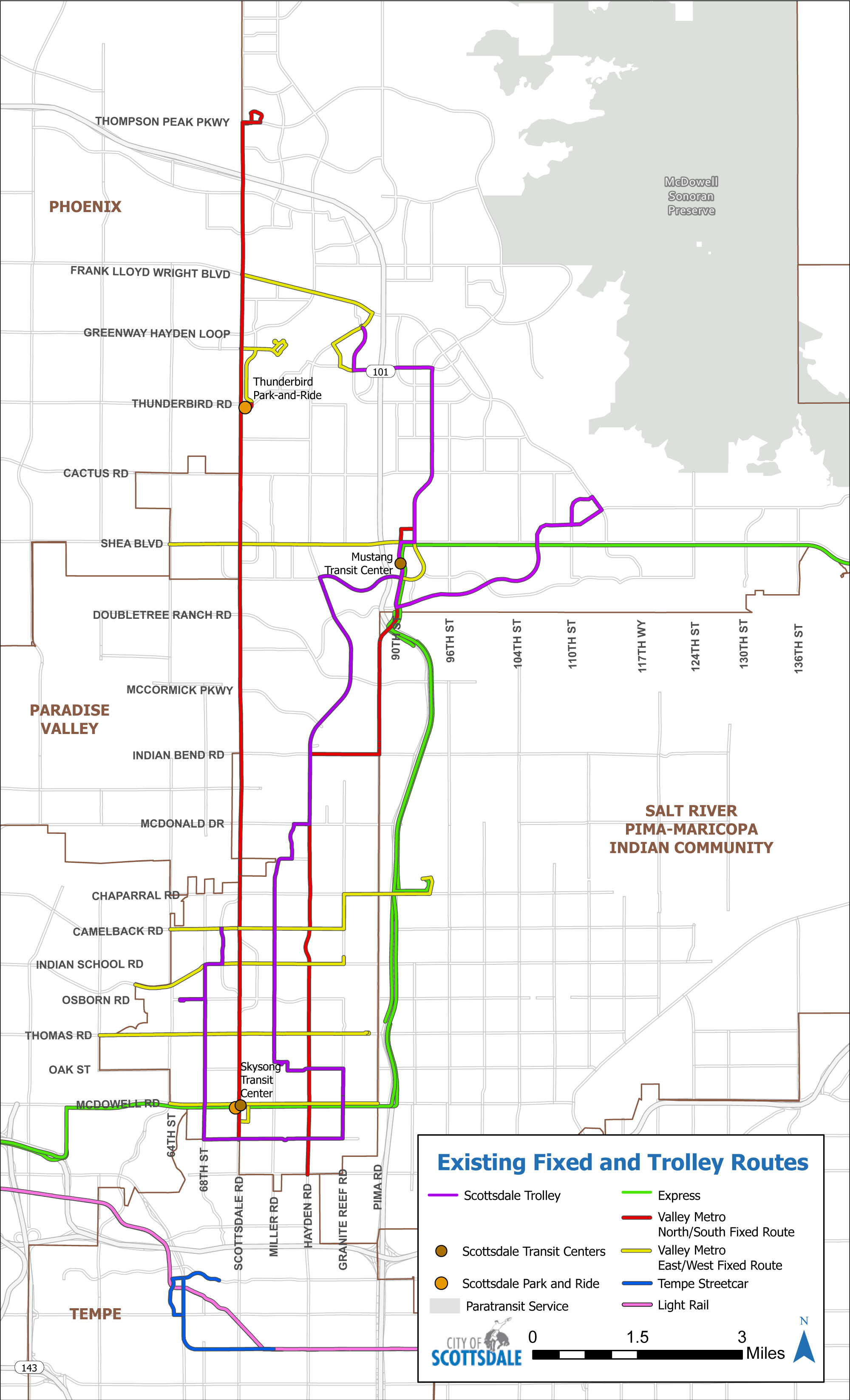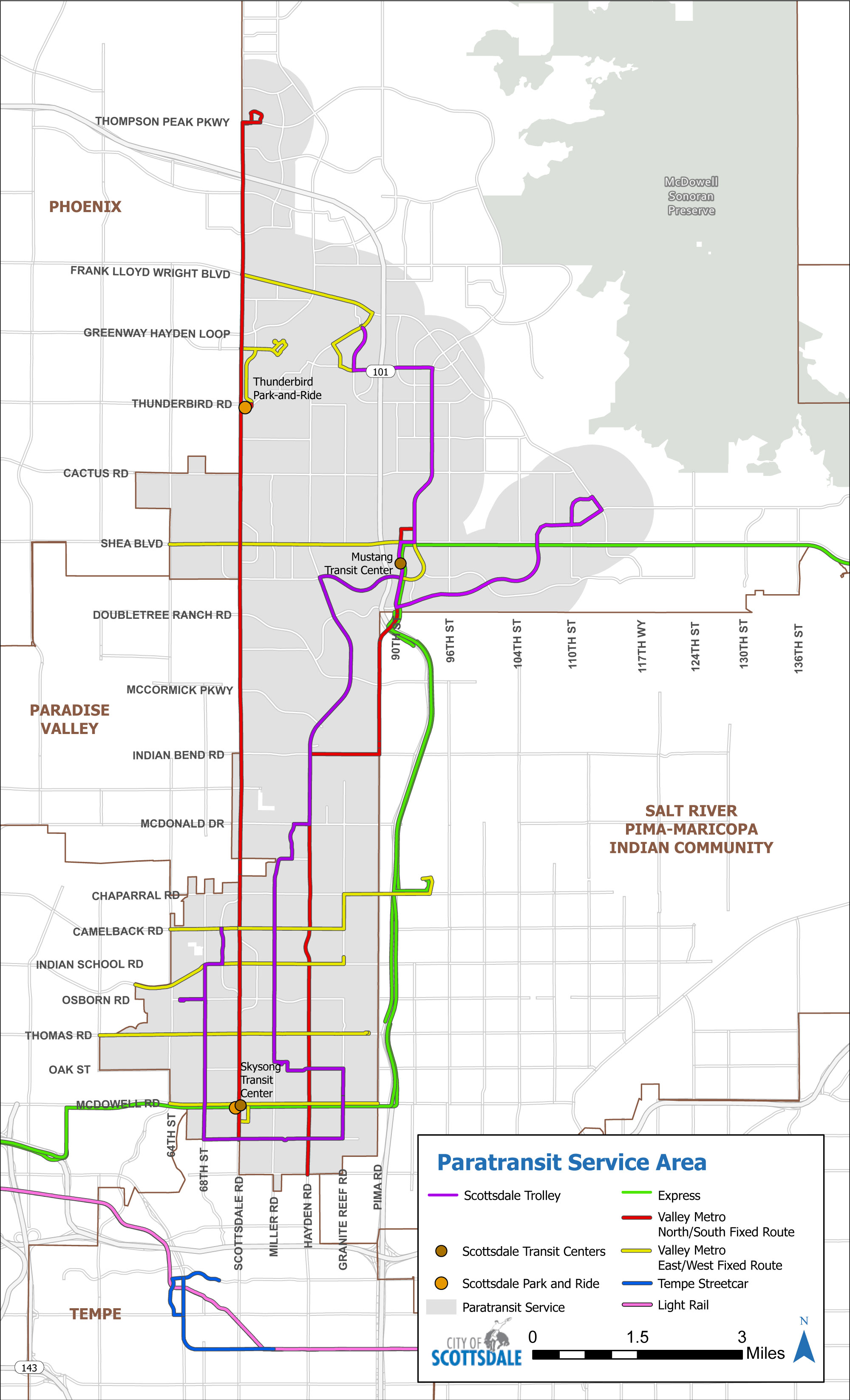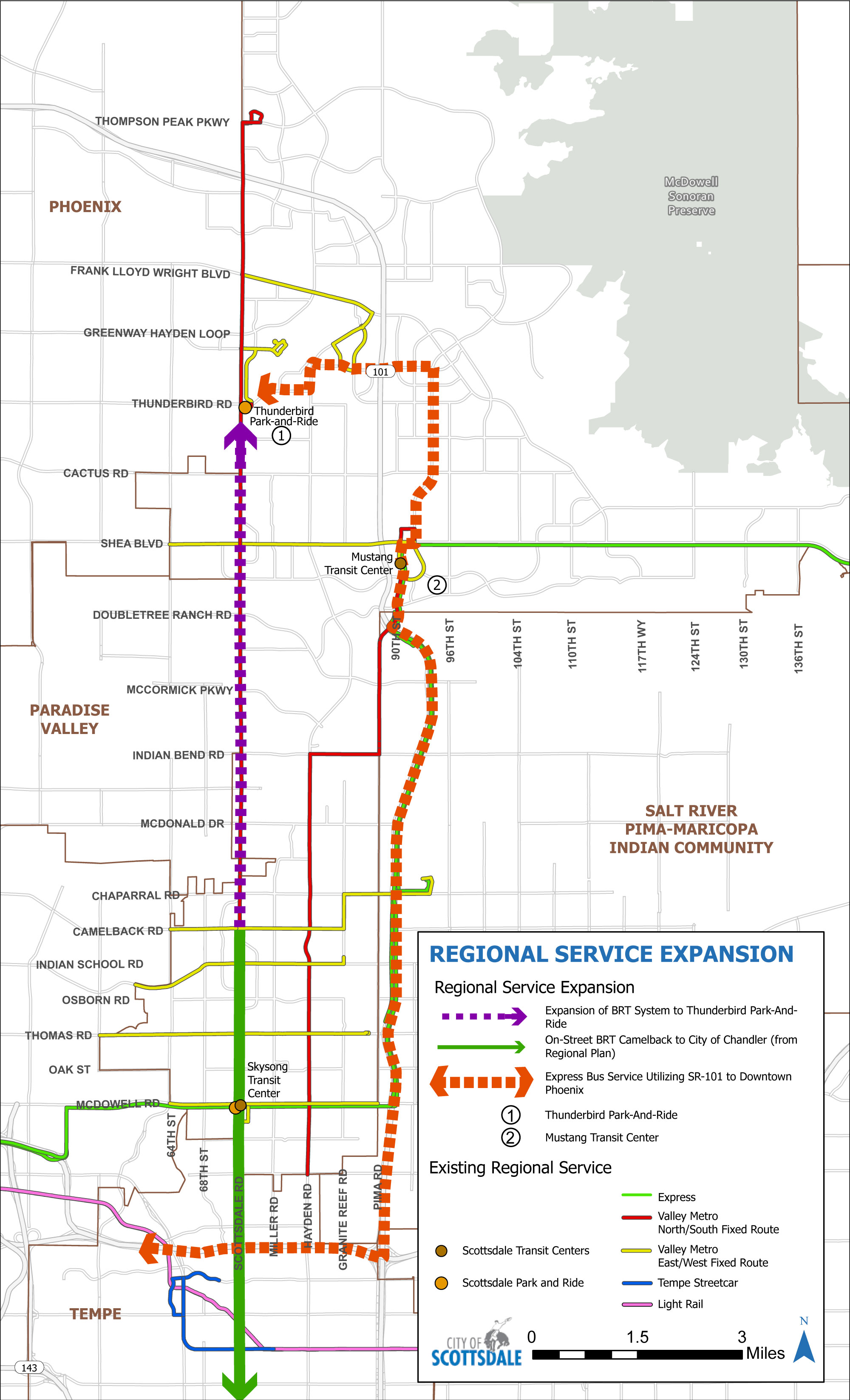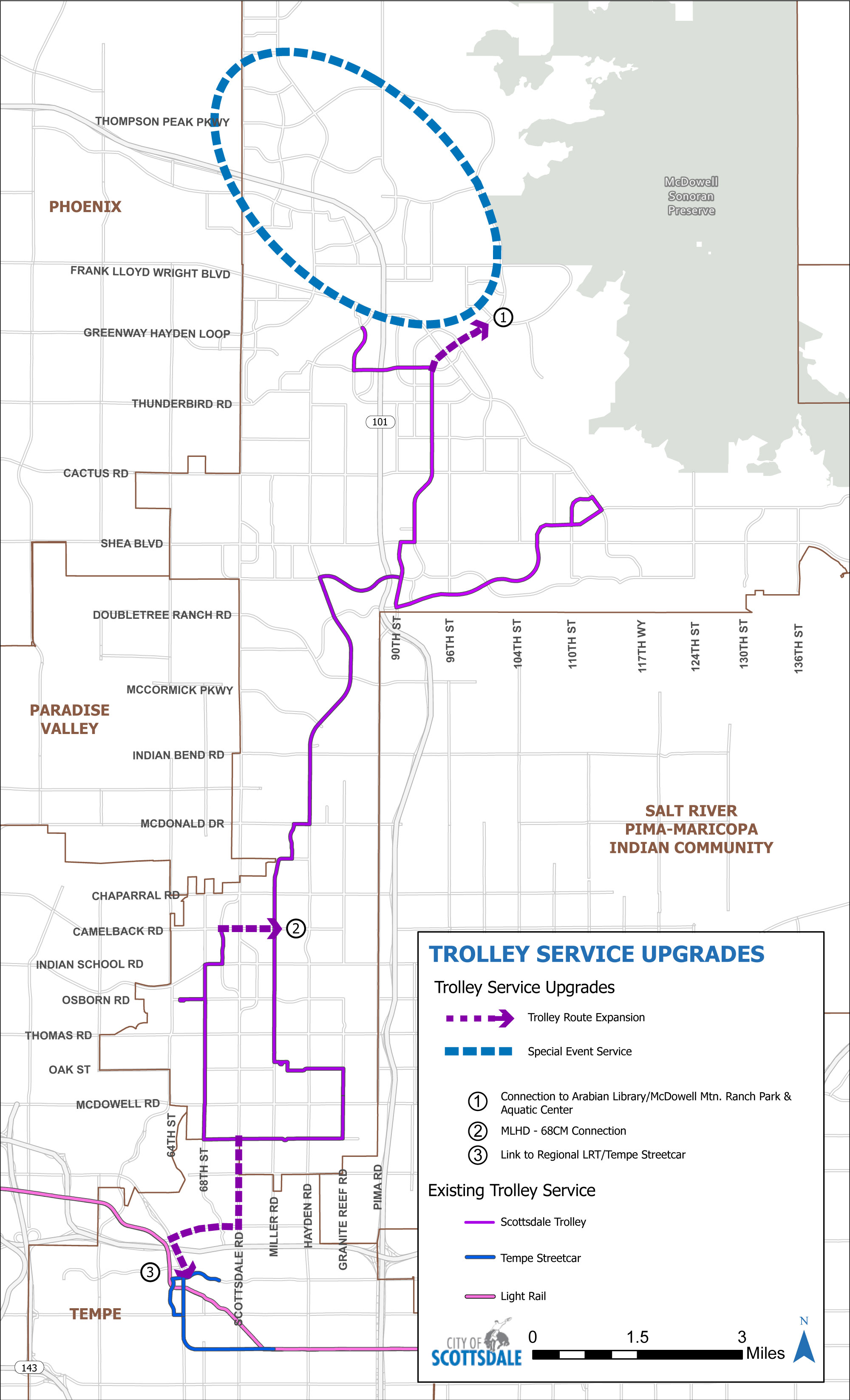Transit Element
Skip to:
Goals Policies Current Transit System Facilities Planned Improvements Performance Measures
Introduction
Public transit is a key component of the city’s transportation network and a critical mobility alternative for Scottsdale residents, visitors and workers. The Public Transit Element of the Scottsdale Transportation Action Plan (TAP) provides guidance on maintaining a viable transit system and expanding service to meet the needs of the community and region. This guidance aligns with the Connectivity section of the draft 2035 Scottsdale General Plan.
Public transit service coincides with Scottsdale’s unique character areas, each with varying needs and lifestyles. It also serves visitors from all over the world, along with a large seasonal population. An effective transit service must provide transportation choices for those who elect to use transit, as well as those who are dependent on it by integrating future technology and micro-mobility solutions. Ultimately, transit planning aims to enhance connectivity to schools and inter-jurisdictional coordination; provide accessible mobility choices; reduce congestion and pollution; and improve quality of life.
A robust transit system does not stop at city boundaries but makes strong connections to the regional system. Routes should effectively serve major employment hubs, activity centers, local businesses and schools throughout Scottsdale and provide transfers to other routes that link to various parts of the Valley. Convenient and safe access to transit supports employees who work within and outside of Scottsdale, along with students, from elementary to college age.
The future for Scottsdale transit hinges on the ability to leverage and build on the existing bus system and improve connectivity to the rest of the region through cost-effective and data-driven solutions. Transit changes go through a regional public involvement process twice a year, and proposed modifications are based on public input, ridership, public requests, survey data and funding. Continuing to build strong partnerships with neighboring communities, such as Phoenix and Tempe, and Valley Metro, the regional transit agency, is very important for ensuring a successful transit system in Scottsdale.
Continued funding for Scottsdale public transit also relies on people choosing to use it. To ensure transit service is attractive and competitive with other forms of transportation, it must be frequent, fast and convenient. In addition, the vehicles and bus facilities must be clean, reliable and comfortable.
Scottsdale Transportation & Streets developed a series of transit improvement strategies to be phased in over the next five to ten years. Planned improvements closely align with the draft 2035 General Plan and are consistent with the Scottsdale City Council’s objective of "Advancing Transportation."
Goals
- Build a viable, cost effective, reliable public transportation alternative for all income levels and lifestyles and that coincides with Scottsdale’s unique character areas, each with varying needs. Effective transit service provides citizens, visitors, a seasonal population and special events with transportation choices.
- Develop routes that effectively serve major employment, commercial and retail uses; community and senior centers; schools; and other activity centers throughout Scottsdale, and that connect to the regional system.
- Focus service on the transit-dependent population, as well as those who choose public transit for their transportation.
- Continually monitor and improve paratransit programs as boundaries change with transit improvements.
- Implement service and amenities to make the system more convenient to use and sustainable over time. Special consideration will be given to emerging technologies and infrastructure that improve service, mitigate the extreme heat and help reduce emissions.
- Ensure that all transit assets, including the bus fleet, bus stops and park-and-ride facilities, are in a state of good repair.
- Link the city’s extensive active transportation network for pedestrians and cyclists directly to the public transit system.
- Improve connections to the region’s expanding High-Capacity Transit system (Light Rail, Streetcar, and Bus Rapid Transit) and provide convenient transfers to fixed service routes that link to other parts of the Valley.
- Build upon the goals in the draft 2035 General Plan and the overall goal of Scottsdale City Council to “Advance Transportation.” Provide transit investments that can be implemented with sustainable funding.
- Maximize use of existing transit facilities (transit centers, park-and-rides, bus stops) to strengthen connections to local, fixed route, express and other potential transit modes and provide needed amenities and parking for those utilizing the transit system.
Policies
- Service standards for Scottsdale’s local bus routes ensure a 30-minute minimum frequency of service.
- The standard for local bus stops is placement at 1/4-mile intervals.
- To comply with National Transit Database reporting requirements, financial and system information will be reconciled quarterly.
- Gather key transit system data by using Automated Passenger Counters and Clever Devices to analyze, measure and ensure the success of the system.
- Review bus route performance at the segment level to evaluate and implement necessary changes to ensure successful routes and passenger connections within the transit system.
Current Transit System
Existing transit service in Scottsdale is characterized by regional fixed route buses operating on the arterial and collector street grid system, express bus service, the trolley system and paratransit. (See Figure 1.) Scottsdale currently has nine fixed routes, one express route and four trolley routes.
It is important to note that Trolley is the brand name for Scottsdale’s owned and operated bus service, which differs from fixed routes by providing direct routes (without transfers) to selected activity centers in Scottsdale. Trolley routes also deliver better connectivity between neighborhoods, commercial corridors and the regional system. The Scottsdale Trolley is a free service funded by the 0.2% Scottsdale Transportation Sales Tax. Scottsdale also receives preventative maintenance funds from the Federal Transit Administration (FTA), Arizona Lottery Funds and other federal grants to offset a portion of trolley operating expenses. In addition, all trolley buses are purchased with FTA grant funds, which typically have a 15% to 20% local match requirement. There are currently 21 buses in the city’s trolley fleet.
Scottsdale has intergovernmental agreements (IGAs) with Valley Metro and the city of Phoenix to operate fixed route service, the most common form of transit service in the region. Fixed routes, where the Regional Fare Policy applies, are primarily funded with the Proposition 400 Regional Sales Tax and are paid for per mile. It uses standard size transit vehicles (usually 40-foot buses) and is generally characterized by buses operating along the major arterial grid network. The vehicles make frequent stops, and passengers may need to make transfers to reach their destinations. Route 72 on Scottsdale Road is an example of fixed route bus service. Almost all fixed bus routes in Scottsdale connect to other jurisdictions, and the service is contracted to an outside provider. Most transit service is focused south of Frank Lloyd Wright Boulevard, where the highest population, land use densities and need are located.
Express buses operate as commuter service during peak hours and usually connect outlying areas with major activity centers. The routes, with limited a.m. and p.m. trips, typically serve park-and-ride lots or transit centers and may parallel fixed route service with fewer stops. Route 510, which travels between Scottsdale’s Mustang Transit Center and downtown Phoenix, is an example of express bus service. Scottsdale is proposing to expand the express bus system by providing a convenient link to and use of the freeway system, the Mustang Transit Center and the Thunderbird Park-and-Ride.
East Valley Dial-a-Ride is a federally mandated demand-responsive paratransit service that does not follow a fixed route. Paratransit provides flexible-schedule, on-demand transportation for those unable to access traditional fixed route service, such as seniors and passengers with disabilities. The Americans with Disabilities Act (ADA) requires that complementary paratransit service be provided in all areas within 3/4 mile of fixed route bus service (See Figure 2). Currently Scottsdale does not have any bus service north of Frank Lloyd Wright Boulevard and residents there fall outside the required paratransit service boundary. To help residents who are outside of the mandated service area, the city participates in the RideChoice program through Valley Metro.
Scottsdale also provides Cab Connection, an alternative program to Dial-A-Ride. Cab Connection offers more flexibility than Dial-a-Ride and operates at less cost to the city using a voucher system. All users must be Scottsdale residents and have a disability, be on dialysis or be age 65 or older. Extended service hours are usually provided for individuals who qualify under ADA.
Facilities
Existing transit facilities in Scottdale range from on-street passenger facilities, such as bus stops, to large facilities, such as park-and-rides and transit centers. Currently, Scottsdale has 524 active bus stop locations for all transit routes that are continually assessed for appropriate amenities, accessibility, and safety, including more lighting opportunities. To date, 250 of those locations have a bench or seating, 163 have transit shelters and 237 provide shade. Scottsdale uses a standard bus shelter kit that includes a bus shelter, seating, a trash receptacle, a bicycle rack and signs. Other amenities, including vertical shade elements for early morning and late afternoon users, should also be considered as technology and funding become available. The following criteria are used for deciding bus shelter locations:
- Bus frequency
- Highest ridership locations, often at the one-mile arterial intersections
- Bus operational requirements
- Pedestrian safety
- Passenger comfort
- Right-of-way availability
Bus stops are planned at ¼-mile intervals on all fixed bus routes and wider spacing for limited-stop/express bus routes. Overall, standard bus stop spacing makes the system more user friendly, as riders know where to expect stops and the city can market or “brand” service along a route.
Currently there are two transit passenger facilities located in Scottsdale. The Thunderbird Park-and-Ride, located adjacent to the Airpark at the southeast corner of Thunderbird and Scottsdale roads, provides 450 parking spaces for transit users who wish to make system connections and leave their vehicle at a secure facility. Planned improvements aim to increase use of the facility by providing access from additional routes. The Mustang Transit Center, located on 90th Street between Shea Boulevard and Mountain View Road outside the Mustang Library, provides amenities for end-of-line users or those making transit connections to other parts of the system. In addition to the two transit facilities, informal park-and-ride agreements have been established for shared parking arrangements at lots throughout Scottsdale.
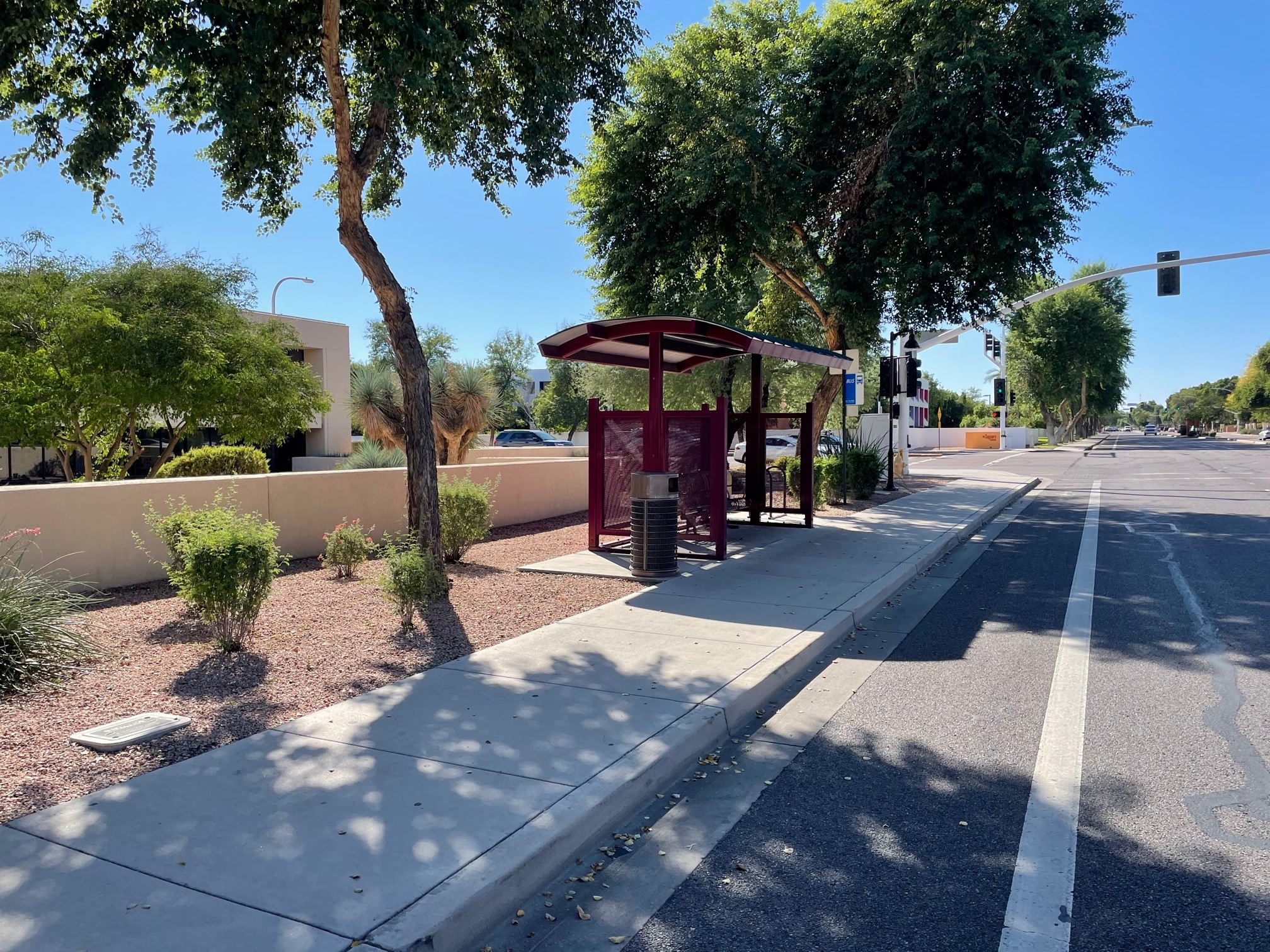
Planned Improvements
Through the planning process, the following phased transit improvement strategies (See Figures 3-4) were developed in addition to the goals and policies. These strategies will help prioritize capital projects and system operational improvements. Consistent with the overall TAP emphasis, the strategies 1) emphasize refining the existing transportation system over adding new infrastructure and 2) emphasize livable streets/community over rapid traffic throughput.
Bus stops
- Improve the bus stop cleaning, refurbishment and prioritization process.
- Expand and improve lighting opportunities at bus stops.
- Improve ADA accessibility at bus stops in conjunction with the city’s ADA Transition Plan.
- Increase shade at bus stops and modify structures to address solutions for full-day coverage.
Service
- Work in tandem with Complete Streets efforts to accommodate all users of the street and make strong ties to the active transportation network.
- Coordinate layover locations on a continual basis to ensure drivers have amenities.
- Modify end-of-line turnarounds as needed to ensure connections are made with productive mileage.
- Provide connectivity between the MLHD and 68CM trolley routes on Camelback Road.
- Implement an express route connecting the Thunderbird Park-and-Ride and Mustang Transit Center to downtown Phoenix using Loop 101 and 202.
- Expand the use of the Thunderbird Park-and-Ride and the Mustang Transit Center.
- Expand service to McDowell Mountain Aquatic Center and Arabian Library.
- Provide special event service for major venues, such as the Waste Management Open and WestWorld events.
Data
- Improve the process and accuracy of reporting revenue miles and costs to the National Transit Database to ensure city compliance to receive federal funding.
- Develop a Transit Asset Management Plan.
- Use Automated Passenger Counter data to evaluate routes at the segment level.
Information
- Market transit services to city staff and the general public through press releases, social media, internal publications and the city website and news feed.
- Provide travel training for potential new rider groups.
- Consider rebranding “Scottsdale Trolley” through a public input process.
Emerging Technology
- Develop an electric bus fleet.
- Improve Transit Signal Priority.
- Expand the use of Clever Devices for increasing system data requirements and communication needs.
Regional Connectivity
- Based on ridership, funding and public comments, improve service frequency on Phoenix and East Valley routes connecting to Scottsdale.
- Expand connectivity to regional Light Rail and Tempe Streetcar with Trolley and fixed route service.
- Connect to on-street Bus Rapid Transit (BRT) routes from Phoenix.
- Evaluate the feasibility of and potentially implement an on-street BRT route on Scottsdale Road from the Thunderbird Park-and-Ride to Chandler. Use of dedicated lanes, while not anticipated, would be subject to review and approval by City Council.
Performance Measures
Service performance measures provide the framework for evaluating our transit service both within and in and out of Scottsdale. Scottsdale evaluates local and regional service using three performance areas: ridership, productivity and quality of service. Performance measures help define the specific modal service levels (frequency), service design (routing) and standards for modifying service and can include existing and future regional fixed routes, trolley service, circulator service, express service, Bus Rapid Transit and paratransit. Performance measures provide a toolbox for determining productivity and managing transit service throughout the system.
The following series of performance measures will help evaluate the success of our existing transit system and future improvements.
- Bus boardings per revenue mile is the number of passengers collected during one mile of scheduled revenue service (productivity).
- Bus boardings per revenue hour is the number of passengers collected during one revenue hour of scheduled revenue service (productivity).
- On-time Performance analyzes whether trips are arriving at time points early, late or on time and determines service reliability for customers (productivity).
- Connectivity to transportation network evaluates the system on a quarterly basis to ensure convenient ties within the city transportation network and to the regional transit system (connectivity).
- Missed trips due to operational failures determines maintenance quality and loss in revenue due to operational interruptions (reliability).
- Rating of bus or transit service on the National Community Survey evaluates public opinion of the system. The city will aim for a positive rating of 60% or better (quality of service).

